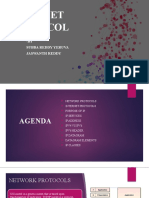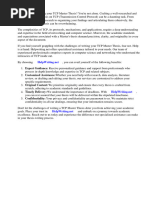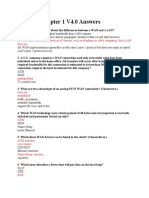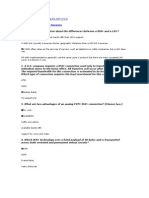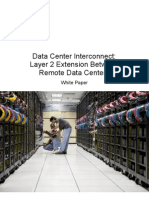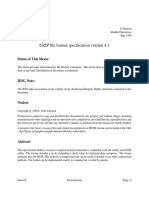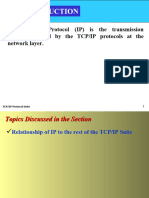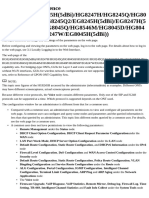RFC 5966
RFC 5966
Uploaded by
chetan666123Copyright:
Available Formats
RFC 5966
RFC 5966
Uploaded by
chetan666123Original Title
Copyright
Available Formats
Share this document
Did you find this document useful?
Is this content inappropriate?
Copyright:
Available Formats
RFC 5966
RFC 5966
Uploaded by
chetan666123Copyright:
Available Formats
Internet Engineering Task Force (IETF)
Request for Comments: 5966
Updates: 1035, 1123
Category: Standards Track
ISSN: 2070-1721
R. Bellis
Nominet UK
August 2010
DNS Transport over TCP - Implementation Requirements
Abstract
This document updates the requirements for the support of TCP as a
transport protocol for DNS implementations.
Status of This Memo
This is an Internet Standards Track document.
This document is a product of the Internet Engineering Task Force
(IETF). It represents the consensus of the IETF community. It has
received public review and has been approved for publication by the
Internet Engineering Steering Group (IESG). Further information on
Internet Standards is available in Section 2 of RFC 5741.
Information about the current status of this document, any errata,
and how to provide feedback on it may be obtained at
http://www.rfc-editor.org/info/rfc5966.
Copyright Notice
Copyright (c) 2010 IETF Trust and the persons identified as the
document authors. All rights reserved.
This document is subject to BCP 78 and the IETF Trusts Legal
Provisions Relating to IETF Documents
(http://trustee.ietf.org/license-info) in effect on the date of
publication of this document. Please review these documents
carefully, as they describe your rights and restrictions with respect
to this document. Code Components extracted from this document must
include Simplified BSD License text as described in Section 4.e of
the Trust Legal Provisions and are provided without warranty as
described in the Simplified BSD License.
Bellis
Standards Track
[Page 1]
RFC 5966
DNS over TCP
August 2010
Table of Contents
1.
2.
3.
4.
5.
6.
7.
8.
9.
1.
Introduction . . . . . . . . . .
Terminology Used in This Document
Discussion . . . . . . . . . . .
Transport Protocol Selection . .
Connection Handling . . . . . . .
Response Reordering . . . . . . .
Security Considerations . . . . .
Acknowledgements . . . . . . . .
References . . . . . . . . . . .
9.1. Normative References . . . .
9.2. Informative References . . .
.
.
.
.
.
.
.
.
.
.
.
.
.
.
.
.
.
.
.
.
.
.
.
.
.
.
.
.
.
.
.
.
.
.
.
.
.
.
.
.
.
.
.
.
.
.
.
.
.
.
.
.
.
.
.
.
.
.
.
.
.
.
.
.
.
.
.
.
.
.
.
.
.
.
.
.
.
.
.
.
.
.
.
.
.
.
.
.
.
.
.
.
.
.
.
.
.
.
.
.
.
.
.
.
.
.
.
.
.
.
.
.
.
.
.
.
.
.
.
.
.
.
.
.
.
.
.
.
.
.
.
.
.
.
.
.
.
.
.
.
.
.
.
.
.
.
.
.
.
.
.
.
.
.
.
.
.
.
.
.
.
.
.
.
.
3
3
3
4
5
6
6
7
7
7
7
Introduction
Most DNS [RFC1034] transactions take place over UDP [RFC0768]. TCP
[RFC0793] is always used for zone transfers and is often used for
messages whose sizes exceed the DNS protocols original 512-byte
limit.
Section 6.1.3.2 of [RFC1123] states:
DNS resolvers and recursive servers MUST support UDP, and SHOULD
support TCP, for sending (non-zone-transfer) queries.
However, some implementors have taken the text quoted above to mean
that TCP support is an optional feature of the DNS protocol.
The majority of DNS server operators already support TCP and the
default configuration for most software implementations is to support
TCP. The primary audience for this document is those implementors
whose failure to support TCP restricts interoperability and limits
deployment of new DNS features.
This document therefore updates the core DNS protocol specifications
such that support for TCP is henceforth a REQUIRED part of a full DNS
protocol implementation.
Whilst this document makes no specific recommendations to operators
of DNS servers, it should be noted that failure to support TCP (or
the blocking of DNS over TCP at the network layer) may result in
resolution failure and/or application-level timeouts.
Bellis
Standards Track
[Page 2]
RFC 5966
2.
DNS over TCP
August 2010
Terminology Used in This Document
The key words "MUST", "MUST NOT", "REQUIRED", "SHALL", "SHALL NOT",
"SHOULD", "SHOULD NOT", "RECOMMENDED", "MAY", and "OPTIONAL" in this
document are to be interpreted as described in [RFC2119].
3.
Discussion
In the absence of EDNS0 (Extension Mechanisms for DNS 0) (see below),
the normal behaviour of any DNS server needing to send a UDP response
that would exceed the 512-byte limit is for the server to truncate
the response so that it fits within that limit and then set the TC
flag in the response header. When the client receives such a
response, it takes the TC flag as an indication that it should retry
over TCP instead.
RFC 1123 also says:
... it is also clear that some new DNS record types defined in the
future will contain information exceeding the 512 byte limit that
applies to UDP, and hence will require TCP. Thus, resolvers and
name servers should implement TCP services as a backup to UDP
today, with the knowledge that they will require the TCP service
in the future.
Existing deployments of DNS Security (DNSSEC) [RFC4033] have shown
that truncation at the 512-byte boundary is now commonplace. For
example, a Non-Existent Domain (NXDOMAIN) (RCODE == 3) response from
a DNSSEC-signed zone using NextSECure 3 (NSEC3) [RFC5155] is almost
invariably larger than 512 bytes.
Since the original core specifications for DNS were written, the
Extension Mechanisms for DNS (EDNS0 [RFC2671]) have been introduced.
These extensions can be used to indicate that the client is prepared
to receive UDP responses larger than 512 bytes. An EDNS0-compatible
server receiving a request from an EDNS0-compatible client may send
UDP packets up to that clients announced buffer size without
truncation.
However, transport of UDP packets that exceed the size of the path
MTU causes IP packet fragmentation, which has been found to be
unreliable in some circumstances. Many firewalls routinely block
fragmented IP packets, and some do not implement the algorithms
necessary to reassemble fragmented packets. Worse still, some
network devices deliberately refuse to handle DNS packets containing
EDNS0 options. Other issues relating to UDP transport and packet
size are discussed in [RFC5625].
Bellis
Standards Track
[Page 3]
RFC 5966
DNS over TCP
August 2010
The MTU most commonly found in the core of the Internet is around
1500 bytes, and even that limit is routinely exceeded by DNSSECsigned responses.
The future that was anticipated in RFC 1123 has arrived, and the only
standardised UDP-based mechanism that may have resolved the packet
size issue has been found inadequate.
4.
Transport Protocol Selection
All general-purpose DNS implementations MUST support both UDP and TCP
transport.
o
Authoritative server implementations MUST support TCP so that they
do not limit the size of responses to what fits in a single UDP
packet.
Recursive server (or forwarder) implementations MUST support TCP
so that they do not prevent large responses from a TCP-capable
server from reaching its TCP-capable clients.
Stub resolver implementations (e.g., an operating systems DNS
resolution library) MUST support TCP since to do otherwise would
limit their interoperability with their own clients and with
upstream servers.
Stub resolver implementations MAY omit support for TCP when
specifically designed for deployment in restricted environments where
truncation can never occur or where truncated DNS responses are
acceptable.
Regarding the choice of when to use UDP or TCP, Section 6.1.3.2 of
RFC 1123 also says:
... a DNS resolver or server that is sending a non-zone-transfer
query MUST send a UDP query first.
That requirement is hereby relaxed. A resolver SHOULD send a UDP
query first, but MAY elect to send a TCP query instead if it has good
reason to expect the response would be truncated if it were sent over
UDP (with or without EDNS0) or for other operational reasons, in
particular, if it already has an open TCP connection to the server.
Bellis
Standards Track
[Page 4]
RFC 5966
5.
DNS over TCP
August 2010
Connection Handling
Section 4.2.2 of [RFC1035] says:
If the server needs to close a dormant connection to reclaim
resources, it should wait until the connection has been idle for a
period on the order of two minutes. In particular, the server
should allow the SOA and AXFR request sequence (which begins a
refresh operation) to be made on a single connection. Since the
server would be unable to answer queries anyway, a unilateral
close or reset may be used instead of a graceful close.
Other more modern protocols (e.g., HTTP [RFC2616]) have support for
persistent TCP connections and operational experience has shown that
long timeouts can easily cause resource exhaustion and poor response
under heavy load. Intentionally opening many connections and leaving
them dormant can trivially create a "denial-of-service" attack.
It is therefore RECOMMENDED that the default application-level idle
period should be of the order of seconds, but no particular value is
specified. In practise, the idle period may vary dynamically, and
servers MAY allow dormant connections to remain open for longer
periods as resources permit.
To mitigate the risk of unintentional server overload, DNS clients
MUST take care to minimize the number of concurrent TCP connections
made to any individual server. Similarly, servers MAY impose limits
on the number of concurrent TCP connections being handled for any
particular client.
Further recommendations for the tuning of TCP stacks to allow higher
throughput or improved resiliency against denial-of-service attacks
are outside the scope of this document.
6.
Response Reordering
RFC 1035 is ambiguous on the question of whether TCP queries may be
reordered -- the only relevant text is in Section 4.2.1, which
relates to UDP:
Queries or their responses may be reordered by the network, or by
processing in name servers, so resolvers should not depend on them
being returned in order.
For the avoidance of future doubt, this requirement is clarified.
Client resolvers MUST be able to process responses that arrive in a
different order to that in which the requests were sent, regardless
of the transport protocol in use.
Bellis
Standards Track
[Page 5]
DNS over TCP
RFC 5966
7.
August 2010
Security Considerations
Some DNS server operators have expressed concern that wider use of
DNS over TCP will expose them to a higher risk of denial-of-service
(DoS) attacks.
Although there is a higher risk of such attacks against TCP-enabled
servers, techniques for the mitigation of DoS attacks at the network
level have improved substantially since DNS was first designed.
At the time of writing, the vast majority of Top Level Domain (TLD)
authority servers and all of the root name servers support TCP and
the author knows of no evidence to suggest that TCP-based DoS attacks
against existing DNS infrastructure are commonplace.
That notwithstanding, readers are advised to familiarise themselves
with [CPNI-TCP].
Operators of recursive servers should ensure that they only accept
connections from expected clients, and do not accept them from
unknown sources. In the case of UDP traffic, this will help protect
against reflector attacks [RFC5358] and in the case of TCP traffic it
will prevent an unknown client from exhausting the servers limits on
the number of concurrent connections.
8.
Acknowledgements
The author would like to thank the document reviewers from the DNSEXT
Working Group, and in particular, George Barwood, Alex Bligh, Alfred
Hoenes, Fernando Gont, Olafur Gudmondsson, Jim Reid, Paul Vixie, and
Nicholas Weaver.
9.
References
9.1.
Normative References
[RFC0768]
Postel, J., "User Datagram Protocol", STD 6, RFC 768,
August 1980.
[RFC0793]
Postel, J., "Transmission Control Protocol", STD 7,
RFC 793, September 1981.
[RFC1034]
Mockapetris, P., "Domain names - concepts and
facilities", STD 13, RFC 1034, November 1987.
[RFC1035]
Mockapetris, P., "Domain names - implementation and
specification", STD 13, RFC 1035, November 1987.
Bellis
Standards Track
[Page 6]
DNS over TCP
RFC 5966
August 2010
[RFC1123]
Braden, R., "Requirements for Internet Hosts Application and Support", STD 3, RFC 1123, October 1989.
[RFC2119]
Bradner, S., "Key words for use in RFCs to Indicate
Requirement Levels", BCP 14, RFC 2119, March 1997.
[RFC2671]
Vixie, P., "Extension Mechanisms for DNS (EDNS0)",
RFC 2671, August 1999.
9.2.
Informative References
[CPNI-TCP]
CPNI, "Security Assessment of the Transmission Control
Protocol (TCP)", 2009, <http://www.cpni.gov.uk/Docs/
tn-03-09-security-assessment-TCP.pdf>.
[RFC2616]
Fielding, R., Gettys, J., Mogul, J., Frystyk, H.,
Masinter, L., Leach, P., and T. Berners-Lee, "Hypertext
Transfer Protocol -- HTTP/1.1", RFC 2616, June 1999.
[RFC4033]
Arends, R., Austein, R., Larson, M., Massey, D., and S.
Rose, "DNS Security Introduction and Requirements",
RFC 4033, March 2005.
[RFC5155]
Laurie, B., Sisson, G., Arends, R., and D. Blacka, "DNS
Security (DNSSEC) Hashed Authenticated Denial of
Existence", RFC 5155, March 2008.
[RFC5358]
Damas, J. and F. Neves, "Preventing Use of Recursive
Nameservers in Reflector Attacks", BCP 140, RFC 5358,
October 2008.
[RFC5625]
Bellis, R., "DNS Proxy Implementation Guidelines",
BCP 152, RFC 5625, August 2009.
Authors Address
Ray Bellis
Nominet UK
Edmund Halley Road
Oxford OX4 4DQ
United Kingdom
Phone: +44 1865 332211
EMail: ray.bellis@nominet.org.uk
http://www.nominet.org.uk/
URI:
Bellis
Standards Track
[Page 7]
You might also like
- Internet ProtocolDocument86 pagesInternet ProtocolIndu KommulaNo ratings yet
- ICT2103 - Assignment - August2015 (Group 2 Tan Yih Wei) BVDocument10 pagesICT2103 - Assignment - August2015 (Group 2 Tan Yih Wei) BVHoh Jia HengNo ratings yet
- WebRTC: APIs and RTCWEB Protocols of the HTML5 Real-Time Web, Third EditionFrom EverandWebRTC: APIs and RTCWEB Protocols of the HTML5 Real-Time Web, Third EditionRating: 5 out of 5 stars5/5 (1)
- User Guide: AC1200 Wireless Dual Band RouterDocument111 pagesUser Guide: AC1200 Wireless Dual Band Routerkyrie eleisonNo ratings yet
- RFC 7901Document16 pagesRFC 7901wl.teo.sgNo ratings yet
- TCP Master ThesisDocument7 pagesTCP Master ThesisPayToDoMyPaperPortland100% (2)
- RFC 6349Document27 pagesRFC 6349nu_am_chef_aziNo ratings yet
- Internet Performance in The Middle EastDocument5 pagesInternet Performance in The Middle EastFiraz_maNo ratings yet
- rfc2818 HTTP Over TLSDocument7 pagesrfc2818 HTTP Over TLSmihailsapovalov05No ratings yet
- Enhanced Transaction TCP-Design and Implementation: 1.1 What Is T/TCP 1.2 Why T/TCPDocument10 pagesEnhanced Transaction TCP-Design and Implementation: 1.1 What Is T/TCP 1.2 Why T/TCPJetesh DevgunNo ratings yet
- rfc6296 NAPT v6Document33 pagesrfc6296 NAPT v6Tiago ZacariasNo ratings yet
- Real Time Communications Over UDP Protocol - CodeProjectDocument12 pagesReal Time Communications Over UDP Protocol - CodeProjectTauseef AhmadNo ratings yet
- Communication Load of TCP With Delayed ACK and UDP in Network On ChipDocument5 pagesCommunication Load of TCP With Delayed ACK and UDP in Network On ChipJournal of ComputingNo ratings yet
- Written Assignment Unit 6 CommDocument5 pagesWritten Assignment Unit 6 CommZodwa MngometuluNo ratings yet
- VxLAN rfc7348Document22 pagesVxLAN rfc7348VincentNo ratings yet
- CCNP Route 300-101 Dump by Alozie CharlesDocument101 pagesCCNP Route 300-101 Dump by Alozie CharlesKAy Cee100% (4)
- RFC 4944 Transmission of IPv6 Packets Over IEEE 802Document35 pagesRFC 4944 Transmission of IPv6 Packets Over IEEE 802elfonchNo ratings yet
- Draft Hirano Httpbis Websocket Over http2 00Document17 pagesDraft Hirano Httpbis Websocket Over http2 00517wangyiqiNo ratings yet
- Lo2 Security AashaDocument6 pagesLo2 Security AashawayneNo ratings yet
- Using OLSR For Streaming Video in 802.11 Ad Hoc Networks To Save BandwidthDocument10 pagesUsing OLSR For Streaming Video in 802.11 Ad Hoc Networks To Save BandwidthMohammad YusufNo ratings yet
- RFC 6888Document15 pagesRFC 6888NelsonbohrNo ratings yet
- Difference Between TCP and UDP ProtocolDocument5 pagesDifference Between TCP and UDP ProtocolbipworldNo ratings yet
- Tcpip PDFDocument31 pagesTcpip PDFmrwanzNo ratings yet
- RFC 8511Document13 pagesRFC 8511calin.manoleNo ratings yet
- Introduction To QoSDocument11 pagesIntroduction To QoSJose Luis JaramilloNo ratings yet
- DHTTP: An Efficient and Cache-Friendly Transfer Protocol For Web TrafficDocument10 pagesDHTTP: An Efficient and Cache-Friendly Transfer Protocol For Web Trafficmahanbhavsar143No ratings yet
- Route - 300-101 TQDocument320 pagesRoute - 300-101 TQNguyen Anh0% (1)
- 4th RTS SLTN SakDocument9 pages4th RTS SLTN Saknitishbhardwaj100% (1)
- The Business Case For Caching in 4G LTE Networks: WhitepaperDocument7 pagesThe Business Case For Caching in 4G LTE Networks: Whitepaperkostas_ntougias5453No ratings yet
- CCNA 4 Chapter 1 V4.0 AnswersDocument35 pagesCCNA 4 Chapter 1 V4.0 Answers------------ CessNo ratings yet
- Case 4-3Document2 pagesCase 4-3tymurray07No ratings yet
- Programming With TCP/IP - Best PracticesDocument31 pagesProgramming With TCP/IP - Best PracticesmrwanzNo ratings yet
- Rfc5128 - State of Peer-To-Peer (P2P) Communication Across NATDocument33 pagesRfc5128 - State of Peer-To-Peer (P2P) Communication Across NATnopeiccoNo ratings yet
- Reducing Client Connection Delays When DNS Is Unresponsive (Doc ID 1449843.1)Document4 pagesReducing Client Connection Delays When DNS Is Unresponsive (Doc ID 1449843.1)José Laurindo ChiappaNo ratings yet
- Basic NetworkingDocument8 pagesBasic Networkingfantasyking2023No ratings yet
- Performance Tuning On Linux-TCPDocument6 pagesPerformance Tuning On Linux-TCPSK_shivamNo ratings yet
- Congestion Management and Buffering WPDocument10 pagesCongestion Management and Buffering WPMuhammad UsmanNo ratings yet
- Datocom AnswersDocument11 pagesDatocom AnswersHalefom DestaNo ratings yet
- CCNA 4 (All Topics and Final)Document130 pagesCCNA 4 (All Topics and Final)subarusuNo ratings yet
- 3582_Helfinstine_3976_paperDocument11 pages3582_Helfinstine_3976_paperreenaharnalNo ratings yet
- T/TCP: TCP For TransactionsDocument10 pagesT/TCP: TCP For Transactionsprofessor_manojNo ratings yet
- Cisco Real-Exams 300-101 v2019-03-23 by Barbra 469qDocument243 pagesCisco Real-Exams 300-101 v2019-03-23 by Barbra 469qJorge ArmasNo ratings yet
- Introduction To DiameterDocument18 pagesIntroduction To DiameterLin Thein NaingNo ratings yet
- TFTP DocumantationDocument10 pagesTFTP DocumantationBehzad hassanNo ratings yet
- RC 21785Document14 pagesRC 21785Yiyi Valerie ZhangNo ratings yet
- TCP Over 2.5-3G Wireless Networks PDFDocument2 pagesTCP Over 2.5-3G Wireless Networks PDFKrishanu ModakNo ratings yet
- 300-101 New Dump Oct 2016 PDFDocument21 pages300-101 New Dump Oct 2016 PDFjustanotherrandomdudeNo ratings yet
- Configuration IPv4 MVPNDocument28 pagesConfiguration IPv4 MVPNHieuNBNo ratings yet
- CongestionDocument15 pagesCongestionAnshNo ratings yet
- Layer 2 Extension CiscoDocument30 pagesLayer 2 Extension CiscoSatish IitkgpNo ratings yet
- RFC 9113 - HTTP - 2Document95 pagesRFC 9113 - HTTP - 2xakaya1418No ratings yet
- Assignment 4: Real Time System and SoftwareDocument9 pagesAssignment 4: Real Time System and SoftwareSurendra Singh ChauhanNo ratings yet
- Chapter 2. Building Blocks of TCP: High Performance Browser NetworkingDocument13 pagesChapter 2. Building Blocks of TCP: High Performance Browser Networkingsavio77No ratings yet
- Cn2 AssignmentDocument11 pagesCn2 AssignmentVeer ShahNo ratings yet
- rfc8837 (DSCP Marking)Document9 pagesrfc8837 (DSCP Marking)steven.yongNo ratings yet
- TCP and UDP Performance Comparison in Network On ChipDocument5 pagesTCP and UDP Performance Comparison in Network On ChipJournal of ComputingNo ratings yet
- rfc2817.txtDocument13 pagesrfc2817.txtMigoné Roméo Séhi-BiNo ratings yet
- UDP Based Reliable CommunicationDocument5 pagesUDP Based Reliable CommunicationCalin SeitanNo ratings yet
- Chapter 1Document69 pagesChapter 1rekooorekoooNo ratings yet
- Network Programming with Go: Code Secure and Reliable Network Services from ScratchFrom EverandNetwork Programming with Go: Code Secure and Reliable Network Services from ScratchNo ratings yet
- Actress BodyDocument2 pagesActress Bodychetan666123No ratings yet
- GZIP File Format Specification Version 4.3: Status of This MemoDocument12 pagesGZIP File Format Specification Version 4.3: Status of This Memochetan666123No ratings yet
- RFC 3339Document18 pagesRFC 3339chetan666123No ratings yet
- RFC 2606Document5 pagesRFC 2606chetan666123No ratings yet
- RFC 3284Document29 pagesRFC 3284chetan666123No ratings yet
- RFC 4634Document108 pagesRFC 4634chetan666123No ratings yet
- Nutanix NCS-Core v2022-02-14 q63Document27 pagesNutanix NCS-Core v2022-02-14 q63tareqNo ratings yet
- Optimizing Deep Packet Inspection For High-Speed Traffic AnalysisDocument27 pagesOptimizing Deep Packet Inspection For High-Speed Traffic AnalysisSergey McNo ratings yet
- Troubleshooting - IP Routing (V800R002C01 - 01)Document130 pagesTroubleshooting - IP Routing (V800R002C01 - 01)fqtancioNo ratings yet
- Solaris Network CommandsDocument11 pagesSolaris Network Commandskayak_186No ratings yet
- MCQsDocument52 pagesMCQsCulture Table100% (1)
- Intel Omni-Path IP and Storage Router: Design GuideDocument55 pagesIntel Omni-Path IP and Storage Router: Design Guidebsvramesh4489No ratings yet
- Opengear User ManualDocument248 pagesOpengear User ManualjsnNo ratings yet
- Linuxkernnet PDFDocument178 pagesLinuxkernnet PDFizal005No ratings yet
- 712 Whats New in Core BluetoothDocument126 pages712 Whats New in Core BluetoothRaj Bahadur MauryaNo ratings yet
- ConnectionDocument61 pagesConnectionsupport LogsNo ratings yet
- Improving Intrusion Detection and Prevention System (Idps) Performance in An Ipv6 EnvironmentDocument12 pagesImproving Intrusion Detection and Prevention System (Idps) Performance in An Ipv6 EnvironmentAshagre MekuriaNo ratings yet
- Laporan BertestDocument5 pagesLaporan BertestBayu FitriantoNo ratings yet
- IPv4 IPv6 HeaderDocument55 pagesIPv4 IPv6 HeaderDr. Suman RaniNo ratings yet
- TL-WR740N (Un) V6 Ug PDFDocument117 pagesTL-WR740N (Un) V6 Ug PDFblackeye69No ratings yet
- Implementation of Frame Mode MPLSDocument18 pagesImplementation of Frame Mode MPLSrajkumarlodhNo ratings yet
- Lideta R1Document5 pagesLideta R1Anonymous cs4BLczENo ratings yet
- HG8546M Web Page ReferenceDocument127 pagesHG8546M Web Page Referencexebigo7728No ratings yet
- 5 AccDocument14 pages5 Accsac.compuwestNo ratings yet
- Ora Net 1aDocument12 pagesOra Net 1aYulin LiuNo ratings yet
- TS-209 Turbo Station User Manual (Version: 1.0.0)Document166 pagesTS-209 Turbo Station User Manual (Version: 1.0.0)informagicNo ratings yet
- Cisco Catalyst 3550 SwitchDocument11 pagesCisco Catalyst 3550 SwitchAnis AhmedNo ratings yet
- Huawei S6720-LI Series Switches DatasheetDocument29 pagesHuawei S6720-LI Series Switches Datasheetmatthew_mk_au2271No ratings yet
- CN MCQSDocument59 pagesCN MCQSNagineni VenkatesNo ratings yet
- Aci Vxlan - Learn Work ItDocument8 pagesAci Vxlan - Learn Work Itravi kantNo ratings yet
- Gate 2024 Shift 2Document18 pagesGate 2024 Shift 2Alia SharmaNo ratings yet
- Schedule: Vahid Shahbazian Fard Jahromy WWW - Learnmikrotik.Ir ©learnmikrotik - Ir 2014Document22 pagesSchedule: Vahid Shahbazian Fard Jahromy WWW - Learnmikrotik.Ir ©learnmikrotik - Ir 2014Giannis Orfanos50% (2)
- CN Module 3Document46 pagesCN Module 3Rithvik DadapuramNo ratings yet
- Tcpi IpDocument97 pagesTcpi Ipcborn99100% (1)
